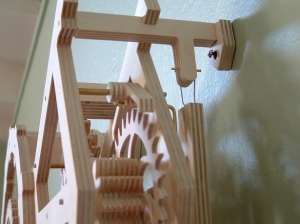Choosing the right wood to build your clock
 Clocks are not normal pieces of furniture or art. Clocks have many intricate pieces that need to work together or the clock will simply not work. Special considerations need to be made when selecting which types of wood to use.
Clocks are not normal pieces of furniture or art. Clocks have many intricate pieces that need to work together or the clock will simply not work. Special considerations need to be made when selecting which types of wood to use.
Dimensional stability
Wood is a material that expands, contracts, and permanently warps over time as temperature and humidity changes. If you have two wooden gears meshing together, having either of the gears swell or warp would prevent the gears from correctly meshing. Therefore, when building any sort of machine out of wood, you need to use wood that is dimensionally stable, and won’t warp much over time. Softwoods are the worst choice. Hardwoods are better, but still have a tendency to warp over time. This is where plywood comes into play.
Plywood
Plywood sheets of wood are constructed from thin layers of wood, with the grains going in an alternate direction. Because of this, plywood is unlikely to warp much in any particular direction. In particular, you’ll want to take a look at Baltic birch plywood. This plywood is made from thin slices of hardwood, which gives you great strength, rigidity and dimensional stability. Baltic birch plywood is also visually appealing to look at, and is affordable. Note how you can see the alternating pattern in the picture above. However, for thin pieces of wood such as 1/8” thick, even Baltic birch plywood can warp beyond what is acceptable. In this case, you can use Finnish birch plywood. Finnish birch plywood uses much thinner layers than Baltic birch plywood, and is much stronger and denser. It is also more expensive, but for 1/8” thick parts, it is still a superior choice most of the time. Unfortunately, it can be difficult to find Finnish birch plywood in big box stores. But you can order online, or if you live near a Woodcraft store, you can browse the wood there.